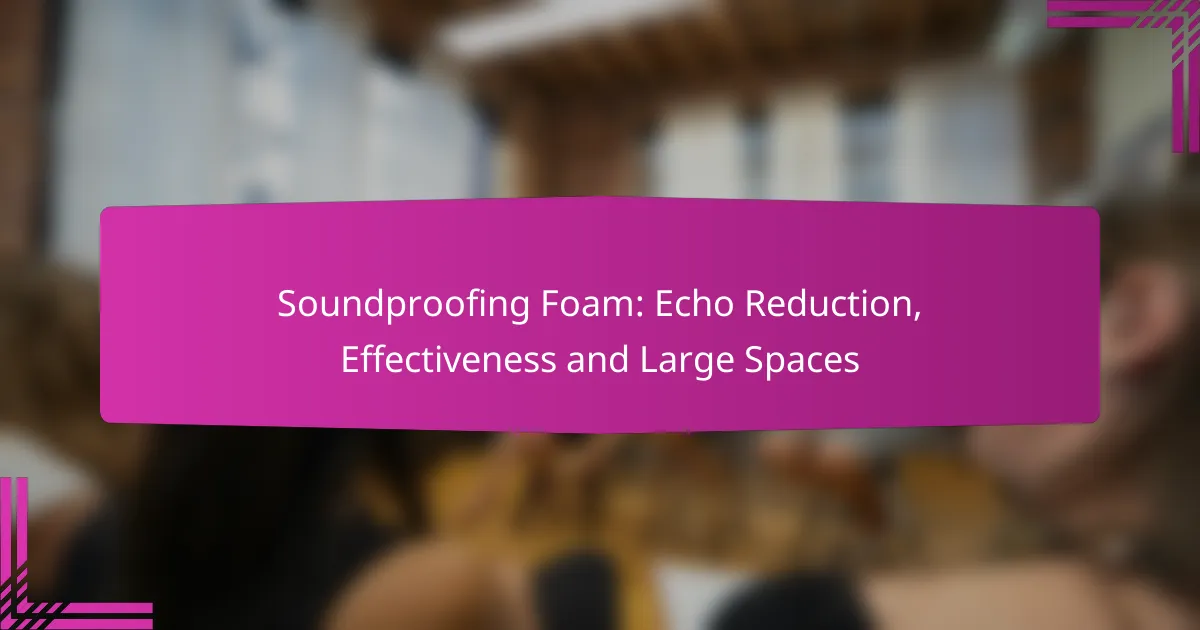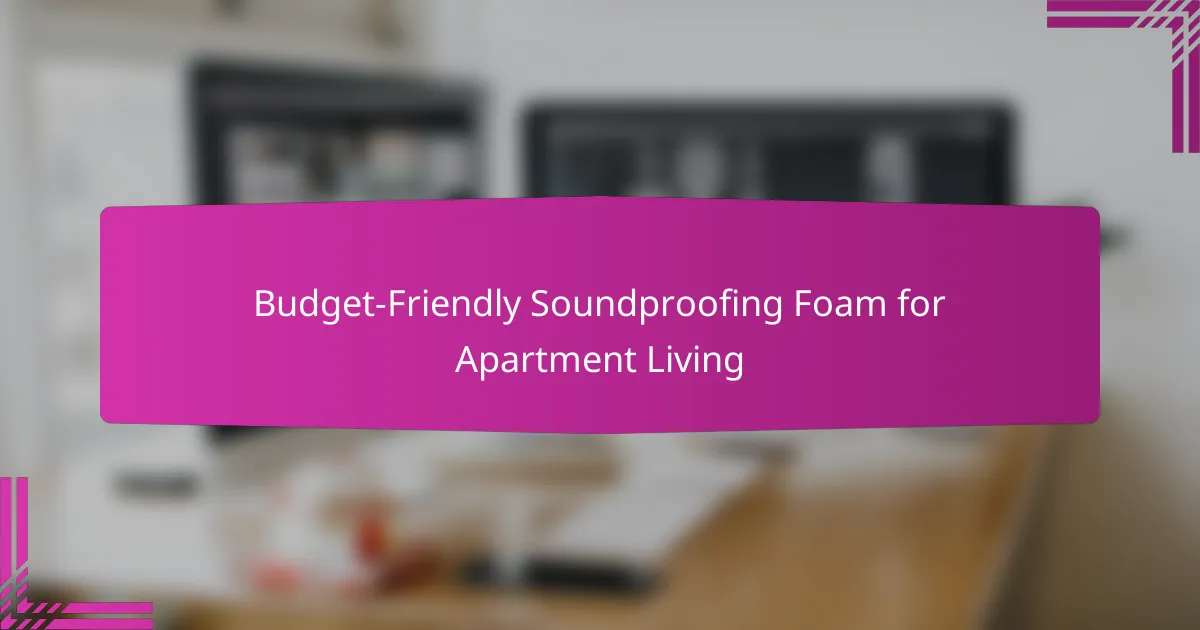Soundproofing foam is essential for reducing echo in large spaces by effectively absorbing sound waves and minimizing reflections. This technology is particularly beneficial in environments such as auditoriums, recording studios, and open offices, where a quieter atmosphere is crucial. By selecting the appropriate type of foam based on room size, layout, and density, one can significantly enhance sound quality and reduce unwanted noise.
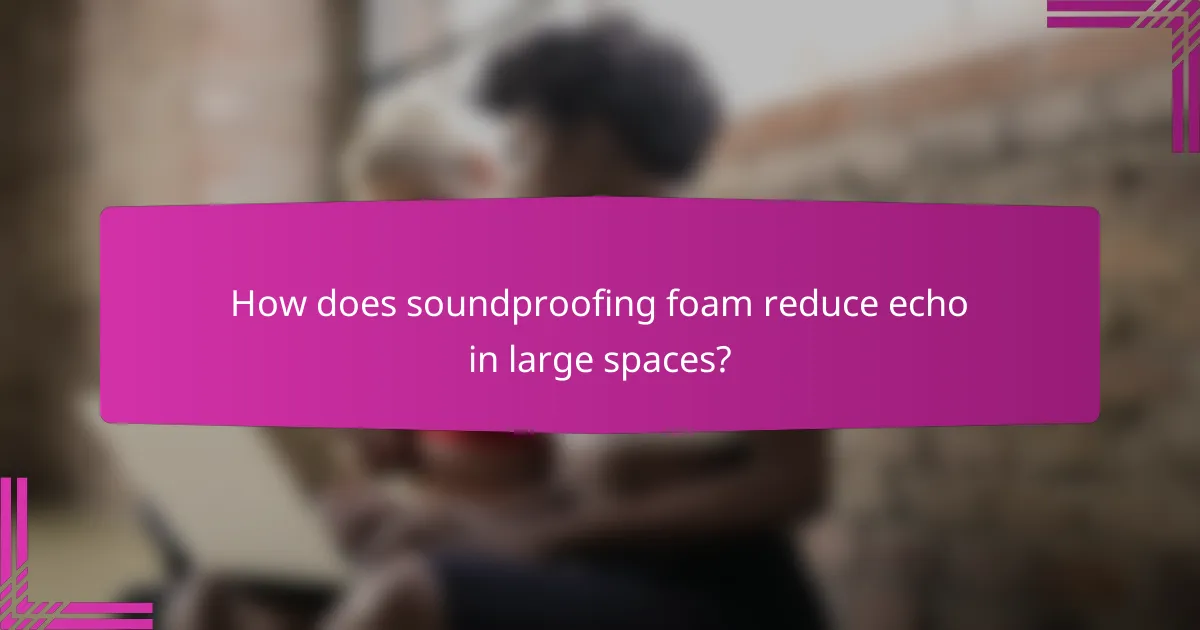
How does soundproofing foam reduce echo in large spaces?
Soundproofing foam reduces echo in large spaces by absorbing sound waves and minimizing reflections. This helps create a quieter environment, making it ideal for venues like auditoriums, recording studios, and open offices.
Absorption of sound waves
Soundproofing foam is designed to absorb sound waves rather than reflect them. When sound waves hit the foam, the material compresses and dissipates the energy, which reduces the intensity of the sound. This absorption is crucial in large spaces where sound can bounce off hard surfaces, creating echoes.
Different types of foam have varying absorption coefficients, meaning some are more effective than others. For example, open-cell foam typically absorbs more sound than closed-cell foam, making it a better choice for echo reduction.
Reduction of reverberation time
Reverberation time refers to how long sound persists in a space after the source has stopped. Soundproofing foam can significantly reduce this time, leading to clearer audio quality. In large spaces, a reverberation time of less than one second is often desirable for speech clarity.
To achieve optimal results, it’s essential to strategically place foam panels throughout the area. This ensures that sound waves are effectively absorbed, preventing them from bouncing back and causing echoes.
Material density and thickness
The density and thickness of soundproofing foam play a vital role in its effectiveness. Thicker and denser materials tend to absorb lower frequencies better, which is important in large spaces where bass sounds can linger. A thickness of around 2 to 4 inches is often recommended for optimal performance.
When selecting foam, consider the specific acoustic needs of the space. For instance, a music studio may require denser foam to manage bass frequencies, while a conference room might benefit from lighter foam to enhance speech intelligibility.

What types of soundproofing foam are most effective?
The most effective types of soundproofing foam include acoustic panels, egg crate foam, and mass loaded vinyl. Each type serves a specific purpose in reducing echo and sound transmission, making them suitable for various environments.
Acoustic panels
Acoustic panels are designed to absorb sound waves, reducing echo and reverberation in a space. They are typically made from dense foam or fiberglass and can be mounted on walls or ceilings. The effectiveness of acoustic panels depends on their thickness and placement; thicker panels generally provide better sound absorption.
When selecting acoustic panels, consider the size of the room and the frequency of the sounds you want to control. For larger spaces, a combination of different panel sizes and placements can yield optimal results. Look for panels that meet industry standards for sound absorption, such as those rated by ASTM or similar organizations.
Egg crate foam
Egg crate foam is a lightweight, cost-effective option for soundproofing. Its unique shape helps to diffuse sound waves, making it useful for reducing echoes in smaller spaces. While egg crate foam is not as effective as acoustic panels in absorbing sound, it can still improve sound quality when used in conjunction with other materials.
For best results, use egg crate foam in areas where sound reflection is a concern, such as recording studios or home theaters. Ensure that the foam is securely attached to surfaces to maximize its sound-diffusing properties.
Mass loaded vinyl
Mass loaded vinyl (MLV) is a dense, flexible material used to block sound transmission between spaces. It is particularly effective in preventing noise from traveling through walls, floors, and ceilings. MLV can be applied directly to surfaces or sandwiched between layers of drywall for enhanced soundproofing.
When using MLV, consider the weight and thickness of the material, as these factors influence its sound-blocking capabilities. For residential applications, a thickness of 1/8 inch to 1/4 inch is common. Ensure proper installation to achieve the best soundproofing results, as gaps can significantly reduce its effectiveness.
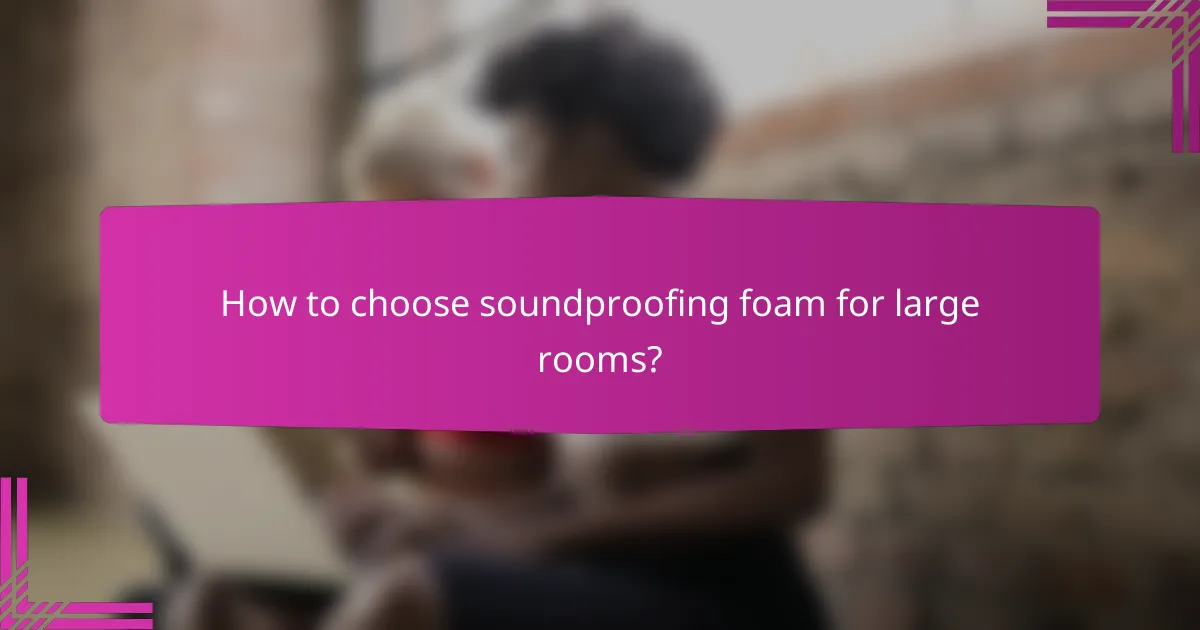
How to choose soundproofing foam for large rooms?
To choose soundproofing foam for large rooms, consider the room’s size, layout, and the foam’s density and NRC ratings. Selecting the right foam involves understanding how these factors influence sound absorption and echo reduction.
Room size and layout considerations
The size and layout of a room significantly impact soundproofing effectiveness. Larger rooms may require more foam to cover surfaces adequately, while irregular shapes can create sound reflections that need targeted treatment. Aim for a balanced distribution of foam across walls and ceilings to minimize echo.
Consider using a mix of foam panels and bass traps, especially in corners, to tackle low-frequency sounds. A common approach is to cover about 20-30% of the total wall area for effective sound absorption.
Foam density and NRC ratings
Foam density plays a crucial role in soundproofing performance. Higher density foams generally absorb sound better than lower density options. Look for foams with a density of at least 30 kg/m³ for effective noise reduction.
NRC (Noise Reduction Coefficient) ratings indicate how well a material absorbs sound. Aim for foams with an NRC rating of 0.7 or higher for large spaces, as this suggests significant sound absorption capabilities.
Installation methods
Proper installation of soundproofing foam is essential for maximizing its effectiveness. Use adhesive spray or double-sided tape for easy application on walls and ceilings. Ensure that the foam is securely attached to prevent gaps that could allow sound leakage.
For optimal results, consider placing foam panels in a staggered pattern rather than lining them up directly. This layout helps to disrupt sound waves and enhances overall absorption. Regularly check the foam for wear and replace it as needed to maintain soundproofing quality.
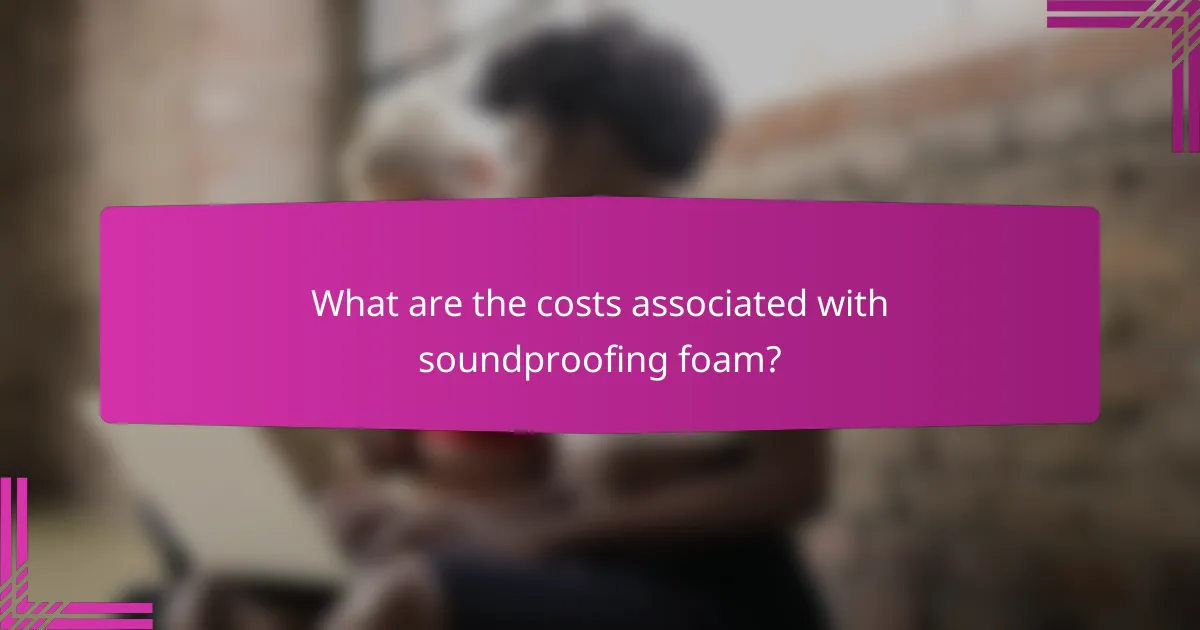
What are the costs associated with soundproofing foam?
The costs of soundproofing foam can vary significantly based on factors like material quality, size of the area, and installation methods. Typically, homeowners can expect to spend anywhere from a few dollars to over twenty dollars per square foot, depending on the specific requirements and choices made.
Price per square foot
The price per square foot for soundproofing foam generally ranges from about $1 to $5 for basic options, while higher-end products can cost between $5 and $20. Factors influencing these prices include the foam’s density, thickness, and acoustic properties. For larger projects, purchasing in bulk may lead to additional savings.
Installation costs
Installation costs for soundproofing foam can vary based on whether you choose to do it yourself or hire a professional. DIY installation may only require basic tools and can save you money, while professional installation services typically range from $50 to $100 per hour, depending on the complexity of the job and local labor rates.
Long-term savings on noise reduction
Investing in soundproofing foam can lead to long-term savings by reducing noise pollution and improving comfort in your space. This can enhance productivity, especially in work environments, and may even increase property value. Additionally, soundproofing can lower heating and cooling costs by improving insulation, leading to further financial benefits over time.

What are the benefits of using soundproofing foam?
Soundproofing foam offers several advantages, including improved audio quality, enhanced privacy, and increased comfort in large spaces. By absorbing sound waves, it minimizes echo and reverberation, making environments more acoustically pleasant.
Improved audio quality
Using soundproofing foam significantly enhances audio quality by reducing echoes and background noise. This is particularly beneficial in recording studios, home theaters, and music practice rooms, where clear sound reproduction is essential.
Foam panels can be strategically placed on walls and ceilings to absorb sound waves at various frequencies. For optimal results, consider using a combination of different foam shapes, such as wedges and pyramids, to target a broader range of sound frequencies.
Enhanced privacy
Soundproofing foam also contributes to enhanced privacy in both residential and commercial settings. By minimizing sound transmission between rooms, it helps ensure conversations and activities remain confidential.
In offices, for instance, installing foam panels can reduce noise from open workspaces, allowing employees to focus better. In homes, it can prevent sounds from traveling between rooms, making it easier to maintain a peaceful environment.
Increased comfort in large spaces
In large spaces, soundproofing foam can create a more comfortable atmosphere by reducing excessive noise levels. This is particularly important in venues like auditoriums, gyms, and conference centers, where sound clarity and comfort are crucial for audience engagement.
To effectively soundproof large areas, consider using a combination of wall-mounted foam panels and ceiling tiles. This approach can help manage sound reflections and create a more inviting environment for gatherings and events.
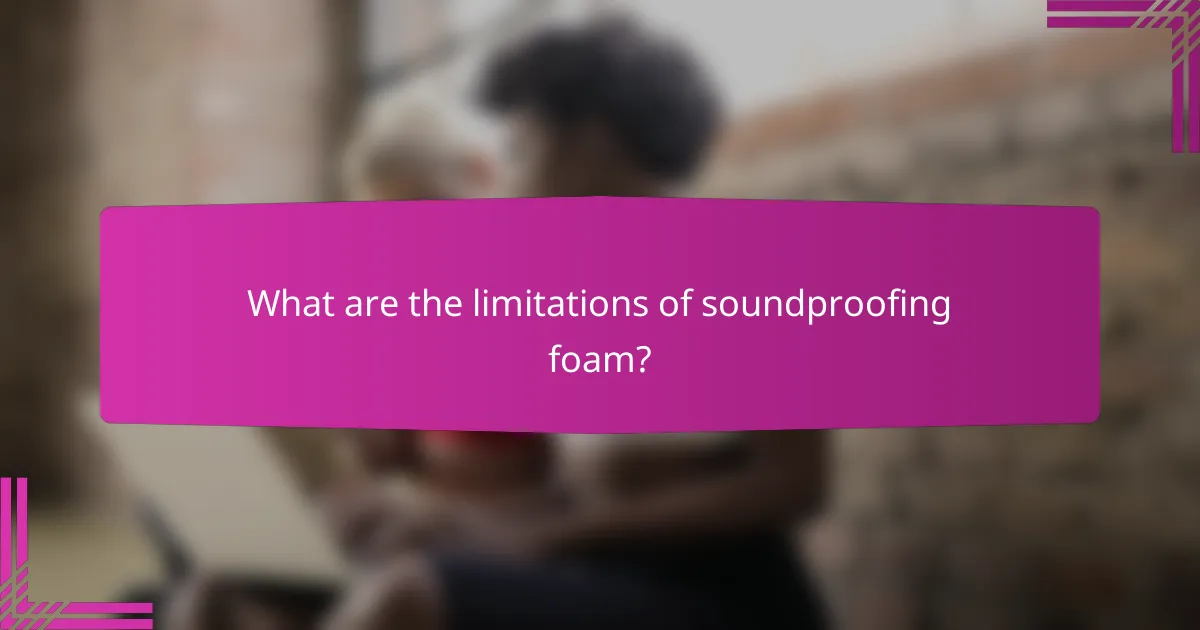
What are the limitations of soundproofing foam?
Soundproofing foam has several limitations that can affect its overall effectiveness in reducing noise. While it can help absorb sound and reduce echo, it does not provide complete sound isolation and varies in performance based on frequency.
Not a complete sound barrier
Soundproofing foam is designed primarily to absorb sound waves, which helps in reducing echo and improving acoustics. However, it does not block sound transmission effectively, meaning that loud noises can still penetrate the foam. For true soundproofing, additional materials like mass-loaded vinyl or drywall may be necessary.
In large spaces, relying solely on foam can lead to significant sound leakage, especially from external sources. Combining foam with other soundproofing techniques can yield better results.
Effectiveness varies by frequency
The effectiveness of soundproofing foam is highly dependent on the frequency of the sound. It tends to absorb higher frequencies better than lower ones, which can result in uneven sound quality. For example, sounds like voices or high-pitched instruments may be muffled, while bass sounds can still be prominent.
To address this, consider using foam with different thicknesses or densities, as thicker foam generally performs better at lower frequencies. This can help create a more balanced acoustic environment in larger spaces.
Potential for aesthetic concerns
While soundproofing foam is functional, it can also raise aesthetic issues, particularly in visible areas. The foam’s appearance may not fit well with all interior designs, leading to a trade-off between functionality and visual appeal.
To mitigate this, consider using foam in colors or patterns that complement your space, or cover it with fabric or decorative panels. This approach allows for effective sound absorption while maintaining the desired aesthetic in large areas.
